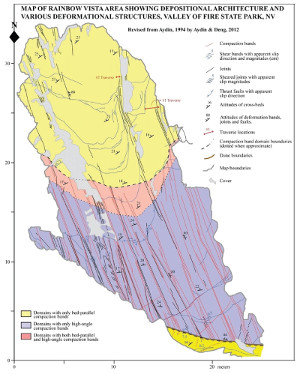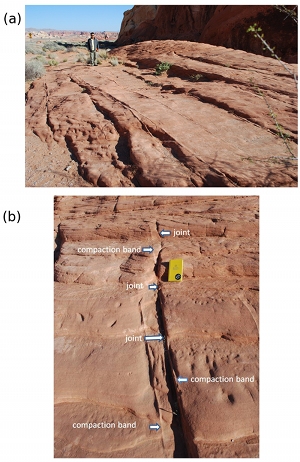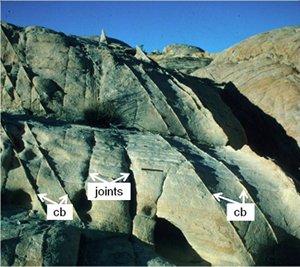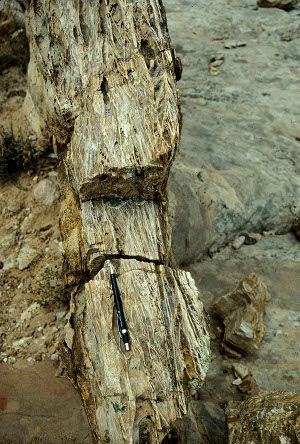|
Although joints and deformation bands are odd structures to form assemblages, they do for various reasons. Here we provide three examples. Figures 1a and b are a map and detailed photograph of a pavement at the Rainbow Vista at Valley of Fire State Park showing an array of joints and sheared joints forming parallel to and right next to a system of deformation bands (compaction bands in this case).
 | | Figure 1. Map showing compaction bands, joints, and sheared joints in various intersection relationships in Aztec Sandstone at the Rainbow Vista in Valley of Fire State Park, Nevada. From Aydin and Deng (2012). |
Figure 2 shows a case in which a joint array makes an acute angle to a set of high-angle compaction bands in the Aztec Sandstone, again in Valley of Fire State Park. It appears that in this case, many of the joints are confined between the compaction bands.
 | | Figure 2. (a) High-angle compaction bands (light-color rib-like features) and sub-parallel joints enhanced by erosional faces with dark shadow due to oblique sun angle from the right. View due North at the central part of the map in Figure 1. (b) Detail picture of one of the assemblages in (a) with compaction bands and overprinting joint labelled. |
Figure 3 and Figure 4 show clear examples of joints cutting across an array of compaction bands and a zone of shear bands in the Aztec and Navajo sandstones, respectively. In these cases the jointing is post deformation banding. Figure 5 shows a case from Grand Central Park, New York, with two sets of bands and two sets of joints, with each joint set sub-parallel the band sets.
 | | Figure 3. One set of compaction bands (cb) with high relief and a younger set of joints with low relief, diagonal to the compaction bands in the Aztec Sandstone, Valley of Fire State Park, Nevada. |
 | | Figure 4. A zone of shear bands being cut-across at high-angle by a younger set of joints iin the Navajo Sandstone, the Waterpocket Monocline, Capitol Reef National Park, Utah. |
 | | Figure 5. Two sets of compaction bands (cb) overprinted by two sets of joints in metasedimentary rocks cropping out at Grand Central Park, New York. Coin (US quarter) for scale. |
| |
Aydin, A., Deng, S., 2012. The Stanford Rock Fracture Project 2012 Field Trip Guidebook. Stanford Digital Repository. Available at: http://purl.stanford.edu/pm733tn8209.
Cakir, M., Aydin, A., 1994. The Stanford Rock Fracture Project 1994 Field Trip Guide. Stanford Digital Repository. Available at: http://purl.stanford.edu/sw988nk5140.
Davatzes, N.C., Aydin, A., 2003. Overprinting faulting mechanisms in sandstone. Journal of Structural Geology 25: 1795 - 1813.
Davatzes, N.C., Eichhubl, P., Aydin, A., 2005. Structural evolution of fault zones in sandstone by multiple deformation mechanisms: Moab fault, southeast Utah. Geological Society of America Bulletin 117: 135-148..
Tindall, S.E., 2006. Jointed deformation bands may not compartmentalize reservoirs. American Association of Petroleum Geologists Bulletin 90: 177-192.
|




